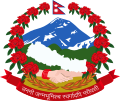This article needs additional citations for verification .(May 2022) |
| This article is part of a series on the |
| Culture of Nepal |
|---|
 |
| Society |
| Arts and literature |
| Others |
| Symbols |
|
| Organizations |
Nepal uses three official calendar systems, including the Nepal Sambat as the main and national calendar, the Vikram Samvat for Hindu holidays, and the Gregorian calendar for international events and holidays.
Contents
- General holidays
- Day Holiday
- Festival Holiday
- Optional holidays
- Observance Holiday
- See also
- References
- External links
Public offices and most private businesses in Nepal operate six days a week and only close on Saturdays. International organizations have their own rules and are normally closed on Saturdays and Sundays. Government holidays for the upcoming year are published in Nepal Gazette. Nepal celebrates a number of religious and non-religious holidays. On most of these holidays, most government offices and private institutions are closed, although is not mandatory for privately owned businesses to close and international organizations may operate their own calendar.
Some of these events are region, religion, or gender-specific. For example, a certain holiday in Nepal can only be for women.
The Government of Nepal has decided to grant a Nation-Wide holiday for a total of 35 days in the year 1142 NS. [1]
The longest consecutive public holiday in Nepal is during Vijaya Dashami. On this festival, holidays fall consecutively i.e. from Fulpati to Duwadashi for seven days. Ghatasthapana and Kojagrat Purnima holidays are part of this festival but are separate from the six-day holiday. These festival holidays do not fall on the same calendar date every year, as they are celebrated on the basis of Lunar dates also known as tithi. Holidays such as Loktantra Diwas (Democracy Day) and Republic day are celebrated on the basis of Nepal Sambat calendar dates.